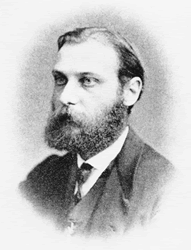- Walther Flemming
Infobox Scientist
name = Walther Flemming
box_width =
image_width =150px
caption = Walther Flemming
birth_date =April 21 1843
birth_place =Sachsenberg
death_date =August 4 1905
death_place =Kiel
residence =
citizenship =
nationality =Germany
ethnicity =
field =
work_institutions =
alma_mater =University of Rostock
doctoral_advisor =
doctoral_students =
known_for =cytogenetics
author_abbrev_bot =
author_abbrev_zoo =
influences =
influenced =
prizes =
religion =
footnotes =
Walther Flemming (April 21 1843 -August 4 1905 ) was a Germanbiologist and the founder ofcytogenetics .He was born in Sachsenberg near
Schwerin as the fifth child and only son of thepsychiatrist Carl Friedrich Flemming (1799-1880) and his second wife, Auguste Winter. He did his basic studies at the "Gymnasium der Residenzstadt", where one of his colleagues and lifelong friends was writerHeinrich Seidel . [http://www.zellbiologie.de/journal/artikel/26_2_2004.pdf] Flemming trained inmedicine at theUniversity of Rostock , graduating in 1868. Afterwards. he served in 1870-1871 as a military physician in theFranco-Prussian War . From 1873 to 1876 he worked as a teacher at theUniversity of Prague . In 1876 he accepted a post as a professor ofanatomy at theUniversity of Kiel . He became the director of the Anatomical Institute and stayed there until his death.Making use of
aniline dye s he was able to find a structure which strongly absorbedbasophilic dyes, which he namedchromatin . He identified that chromatin was correlated to threadlike structures in thecell nucleus — thechromosomes (meaning "coloured body"), which were thus named later on by German anatomistWilhelm von Waldeyer-Hartz (1836-1921). The Belgian scientistEdouard Van Beneden (1846-1910) had independently observed them, too.Flemming investigated the process of
cell division and the distribution of chromosomes to the daughter nuclei, a process he calledmitosis from the Greek word for thread. However, he did not yet realize the splitting into identical halves, the daughter chromatids. He studied mitosis both "in vivo " and in stained preparations, using as the source of biological material thefin s andgill s ofsalamander s. These results were published in 1882 in the seminal book "Zellsubstanz, Kern und Zelltheilung" (1882; Cell Substance, Nucleus and Cell Division). On the basis of his discoveries, Flemming surmised for the first time that all cell nuclei came from another predecessor nucleus (he coined the phrase "omnis nucleus e nucleo", after Virchow's "omnis cellula e cellula").Flemming was unaware of
Gregor Mendel 's (1822-1884) work onheredity , so he did not make the connection between his observations and genetic inheritance. Two decades would pass before the significance of Flemming's work was truly realized with the rediscovery of Mendel's rules. His discovery of mitosis and chromosomes is considered one of the 100 most important scientific discoveries of all times, [ [http://carnegieinstitution.org/cover/top_100/ 100 Greatest Discoveries - Carnegie Institution ] at carnegieinstitution.org] and one of the 10 most important discoveries incell biology [ [http://science.discovery.com/convergence/100discoveries/big100/biology.html The Science Channel :: 100 Greatest Discoveries: Biology ] at science.discovery.com] (together withAugust Weismann 's (1834-1914) discovery ofmeiosis ,Theodor Schwann (1810-1882) andMatthias Schleiden 's (1804-1881)cell theory andThomas Hunt Morgan 's (1866-1945) firstgenetic map s).Flemming's name is honoured by a medal awarded by the
German Society for Cell Biology (Deutschen Gesellschaft für Zellbiologie).References
*Citation
id =PMID :7015236
url= http://www.ncbi.nlm.nih.gov/pubmed/7015236
last=Lukács
first=D
publication-date=1981 Feb 8
year=1981
title= [Walter Flemming, discoverer of chromatin and mitotic cell division]
volume=122
issue=6
periodical=Orvosi hetilap
pages=349-50
*Citation
id =PMID :10829597
url= http://www.ncbi.nlm.nih.gov/pubmed/10829597
last=Latronico
first=N
publication-date=
year=
title= [Heredity, constitution and diathesis]
volume=52
issue=1-2
periodical=Minerva Pediatr.
pages=81-115
*Citation
id =PMID :7050007
url= http://www.ncbi.nlm.nih.gov/pubmed/7050007
last=Breathnach
first=C S
publication-date=1982 Jun
year=1982
title=Biographical sketches No. 18--Flemming.
volume=75
issue=6
periodical=Irish medical journal
pages=177
*Citation
id =PMID :11413469
url= http://www.ncbi.nlm.nih.gov/pubmed/11413469
last=Paweletz
first=N
publication-date=2001 Jan
year=2001
title=Walther Flemming: pioneer of mitosis research.
volume=2
issue=1
periodical=Nat. Rev. Mol. Cell Biol.
pages=72-5
doi = 10.1038/35048077
* Flemming, W. Beitrage zur Kenntniss der Zelle und ihrer Lebenserscheinungen. "Arch. Mikroskop. Anat." 16:302-436 (1878) and 18:151-289 (1880). Reprinted in: "J. Cell Biol." 25:581-589 (1965).
* Carlson, E.A. The Analysis of Mitosis Shifts Attention to the Chromosomes. In: "Mendel's Legacy. The Origins of Classical Genetics". p. 24-5, CSHL Press, 2004. ISBN 0-87969-675-3.External links
* [http://www.laskerfoundation.org/news/gnn/timeline/1882a.html Walther Flemming Biography] . Lasker Labs
* [http://www.dietzellab.de/goodies/history/ Zellsubstanz, Kern und Zelltheilung] . Original text of the book, as PDF (In German).
* [http://www.zellbiologie.de/journal/artikel/3_2_2003.pdf Walter Flemming Medaille] . In PDF, in German.
Wikimedia Foundation. 2010.
